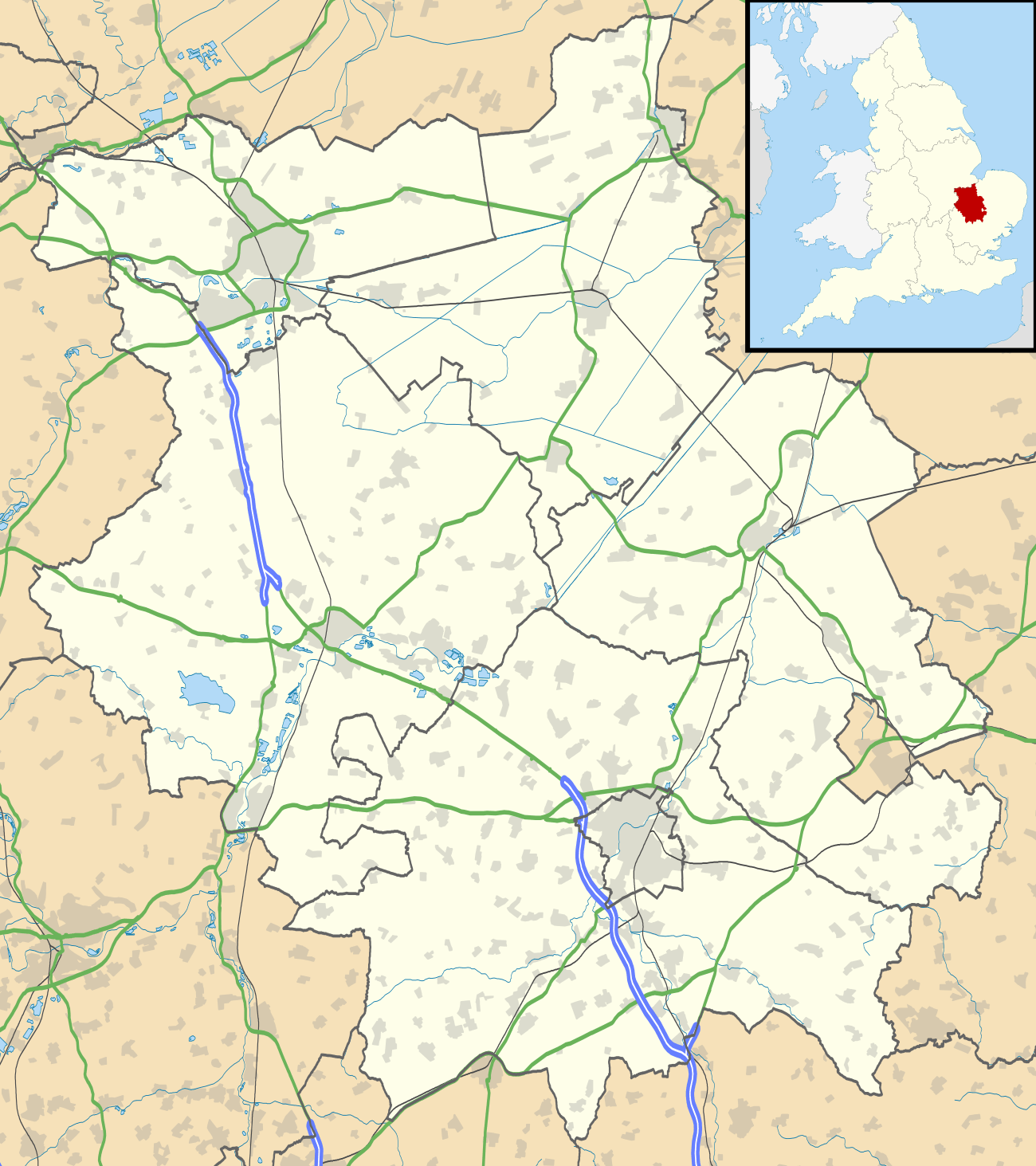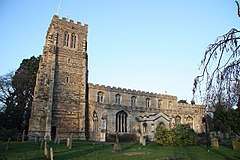Eaton Ford
Eaton Ford is an area of St Neots, Cambridgeshire, England, approximately 81 km (50 mi) north of London. Historically in Bedfordshire, it was transferred to Huntingdonshire in 1965, before becoming part of Cambridgeshire in 1974.[1][2]
| Eaton Ford | |
|---|---|
_-_geograph.org.uk_-_1139411.jpg) Linear sculpture in front of Riverside Park carpark and Ambiance Café which has three playgrounds and a miniature railway | |
 Eaton Ford Location within Cambridgeshire | |
| District | |
| Shire county | |
| Region | |
| Country | England |
| Sovereign state | United Kingdom |
| Post town | ST. NEOTS |
| Postcode district | PE19 |
| Dialling code | 01480 |
| Police | Cambridgeshire |
| Fire | Cambridgeshire |
| Ambulance | East of England |
| UK Parliament | |
Although the majority of St Neots is east of the Great Ouse, Eaton Ford is on the west bank and is still part of the ecclesiastical parish of Eaton Socon. An old cluster of houses is identifiable with a triangular village green. Old farmhouses are dotted among newer houses.
History

In Anglo-Saxon times the place was known as Sudbury but became known as Eaton Ford as it was next to the village (and free land, soke) of Eatun (now Eaton Socon) and hosted a great ford across the river, a main route from the south to the town of St Neots and nearby parts of its county.
In recent decades Eaton Ford expanded quickly (after other parts of St Neots under the London overspill programme). From the 1960s until the 1980s four neighbourhoods/estates have been built:
| Centred on | Name |
|---|---|
| Milton Avenue and Gainsborough Avenue | The Poets |
| The Meadowsweet, Silverweed and Burwell Road | Bovis Homes/Bovis |
| Brook Road and Orchard Road | - |
| Trafalgar Road / Jutland Rise | The Battles[lower-alpha 1] |
- Notes
- From c. 1945 until the 1960s this land hosted the "REME Camp" (of Royal Electrical & Mechanical Engineers)
Smaller infill and brownfield site additions are, as across areas having had sufficient demand in England since the 1990, widespread as meet general planning policy save for protected (such as some heritage)/covenanted land (see Planning Law).
This place has absorbed medieval-founded hamlet Crosshall, still a crossroads in the north, next to St Neots Golf Club which bounds the village briefly. The name 'Crosshall' remains in the name of a local school, a road, and a history board. The secondary triangular green near the main green is Maltmans Green, at the north end of which is The Barley Mow and Barley Court. On this green another history board sets out the history of Crosshall Ford
Government
A second tier of local government operates, Huntingdonshire District Council, headquartered in Huntingdon. It has 52 councillors representing 29 wards.[3] It collects all council tax and administers/provides building regulations, planning and environmental checks/approvals, day centres, assessed housing benefits, parks, waste collections, a communal leisure budget and supports tourism.[4] Eaton Socon lately approximates to the St Neots Eaton Ford ward having two councillors.[3][5] District councillors serve four-year terms after District elections.
The first tier of local government is Cambridgeshire County Council, headquartered in Cambridge. This provides county-wide services such as in road infrastructure, fire and rescue, education, social services, libraries and heritage.[6] Cambridgeshire County Council consists of 69 councillors representing 60 electoral divisions.[7] Eaton Socon is of late in electoral division Little Paxton and St Neots North[5] having two councillors.[7]
In parliamentary elections voters contribute to the Huntingdon seat (constituency).[5] This is represented (in the House of Commons) by Jonathan Djanogly (Con.) since 2001, succeeding Sir John Major (Con.) (1983 to 2001).
Boundaries
The boundaries between Eaton Ford and neighbouring Eaton Socon are arbitrary but in a few places have signposts.
The limits are widely seen as the A1 at Duloe Road, along the latter, to Great North Road (a regular street), then south along the latter to culverted Duloe Brook, then east along the latter to the Ouse, then the latter to St Neots Golf Course, then the latter to the A1. Everything south of the southern limit is associated with Eaton Socon, save Field Cottage Road parallel to the brook, in 1900, like most of the settlement, fields.[8]
References
- "A church near you" Church of England directory of ecclesiastical parishes - map of Eaton Socon E.P. which still includes Eaton Ford
- Young, Rosa (1996), St Neots Past, p 121, Phillimore and Co Ltd. ISBN 1-86077-025-8
- "Huntingdonshire District Council: Councillors". www.huntingdonshire.gov.uk. Huntingdonshire District Council. Retrieved 23 February 2016.
- "Huntingdonshire District Council". www.huntingdonshire.gov.uk. Huntingdonshire District Council. Retrieved 23 February 2016.
- "Ordnance Survey Election Maps". www.ordnancesurvey.co.uk. Ordnance Survey. Retrieved 23 February 2016.
- "Cambridgeshire County Council". www.cambridgeshire.gov.uk. Cambridgeshire County Council. Retrieved 23 February 2016.
- "Cambridgeshire County Council: Councillors". www.cambridgeshire.gov.uk. Cambridgeshire County Council. Archived from the original on 22 February 2016. Retrieved 15 February 2016.
- OS Map: Huntingdonshire XXV.15, Revised: 1900, Published: 1901 - National Library of Scotland interactive maps: https://maps.nls.uk/geo/explore/#zoom=16&lat=52.2208&lon=-0.2872&layers=168&b=7
External links
- Eatons Community Association
- St Neots Town Council – Contains information on Eaton Ford.
- Wikimedia Toolforge - map of georeferenced images in this part of St Neots.